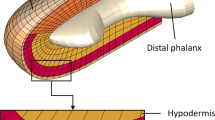Abstract
Purpose
Ultrasound imaging has been a gold standard for clinical diagnoses due to its unique advantages compared to other imaging modalities including: low cost, noninvasiveness, and safeness to the human body. However, the ultrasound scanning process requires applying a large force over extended periods of time, often in uncomfortable postures in order to maintain the desired orientation. This physical requirement over sonographers’ careers often leads to musculoskeletal pain and strain injuries.
Methods
To address this problem, we propose a cooperatively controlled robotic ultrasound system to reduce the force sonographers apply. The proposed system consists of two key components: a six-axis robotic arm that holds and actuates the ultrasound probe, and a dual force sensor setup that enables cooperative control and adaptive force assistance. With the admittance force control, the robotic arm complies with the motion of the operator, while assisting with force during the scanning.
Results
We validated the system through a user study involving expert sonographers and lay people and demonstrated 32–73% reduction in human applied force and 8– 18% improvement in image stability.
Conclusion
These results indicate that the system has the potential to not only reduce the burden on the sonographer, but also provide more stable ultrasound scanning.









Similar content being viewed by others
References
Smith AC, Wolf JG, Xie G-Y, Smith MD (1997) Musculoskeletal pain in cardiac ultrasonographers: results of a random survey. J Am Soc Echocardiogr 10:357–362. doi:10.1016/s0894-7317(97)70073-7
Schoenfeld A, Goverman J, Weiss DM, Meizner I (1999) Transducer user syndrome: an occupational hazard of the ultrasonographer. Eur J Ultrasound 10:41–45. doi:10.1016/s0929-8266(99)00031-2
Priester A, Natarajan S, Culjat M (2013) Robotic ultrasound systems in medicine. IEEE Trans Ultrason Ferroelectr Freq Control 60:507–523. doi:10.1109/tuffc.2013.2593
Koizumi N, Warisawa S, Nagoshi M, Hashizume H, Mitsuishi M (2009) Construction methodology for a remote ultrasound diagnostic system. IEEE Trans Robot 25:522–538. doi:10.1109/tro.2009.2019785
Hennersperger C, Fuerst B, Virga S, Zettinig O, Frisch B, Neff T, Navab N (2016) Towards MRI-based autonomous robotic US acquisitions: a first feasibility study. IEEE Trans Med Imaging. doi:10.1109/tmi.2016.2620723
Salcudean SE, Zhu WH, Abolmaesumi P, Bachmann S, Lawrence PD (2000) A robot system for medical ultrasound. Robot Res. doi:10.1007/978-1-4471-0765-1
Zandsteeg C, Bruijnen D, Molengraft MVD (2010) Haptic tele-operation system control design for the ultrasound task: a loop-shaping approach. Mechatronics 20:767–777. doi:10.1016/j.mechatronics.2010.02.007
Mathiassen K, Fjellin JE, Glette K, Hol PK, Elle OJ (2016) An ultrasound robotic system using the commercial robot UR5. Front Robot AI. doi:10.3389/frobt.2016.00001
Şen HT, Cheng A, Ding K, Boctor E, Wong J, Iordachita I, Kazanzides P (2016) Cooperative control with ultrasound guidance for radiation therapy. Front Robot AI. doi:10.3389/frobt.2016.00049
Balicki M, Uneri A, Iordachita I, Handa J, Gehlbach P, Taylor R (2010) Micro-force sensing in robot assisted membrane peeling for vitreoretinal surgery. Medical Image Computing and Computer-Assisted Intervention - MICCAI 2010. Lect Notes Comput Sci, pp 303–310. doi:10.1007/978-3-642-15711-0_38
He X, Balicki M, Gehlbach P, Handa J, Taylor R, Iordachita I (2014) A multi-function force sensing instrument for variable admittance robot control in retinal microsurgery. In: 2014 IEEE international conference on robotics and automation (ICRA). doi:10.1109/icra.2014.6907037
Casiez GCA, Roussel N, Vogel D (2012) 1 filter. In: Proceedings of the 2012 ACM annual conference on human factors in computing systems—CHI ’12. doi:10.1145/2207676.2208639
Gilbertson MW, Anthony BW (2013) An ergonomic, instrumented ultrasound probe for 6-axis force/torque measurement. In: 2013 35th annual international conference of the IEEE engineering in medicine and biology society (EMBC). doi:10.1109/embc.2013.6609457
Li M, Kapoor A, Taylor R (2005) A constrained optimization approach to virtual fixtures. In: 2005 IEEE/RSJ international conference on intelligent robots and systems. doi:10.1109/iros.2005.1545420
Zhang HK, Cheng A, Bottenus N, Guo X, Trahey GE, Boctor EM (2016) Synthetic tracked aperture ultrasound imaging: design, simulation, and experimental evaluation. J Med Imaging. doi:10.1117/1.jmi.3.2.027001
Zhang HK, Finocchi R, Apkarian K, Boctor EM (2016) Co-robotic synthetic tracked aperture ultrasound imaging with cross-correlation based dynamic error compensation and virtual fixture control. In: 2016 IEEE international ultrasonics symposium (IUS). doi:10.1109/ultsym.2016.7728522
Zhang HK, Fang TY, Finocchi R, Boctor EM (2017) High resolution three-dimensional robotic synthetic tracked aperture ultrasound imaging: feasibility study. In: SPIE: Medical Imaging, p 10139. doi:10.1117/12.2254707
Acknowledgements
This work was funded by Johns Hopkins University internal funds.
Author information
Authors and Affiliations
Corresponding author
Ethics declarations
Conflict of interest
All authors declare that they have no conflict of interest.
Ethical approval
All procedures performed in studies involving human participants were in accordance with the ethical standards of the institutional and/or national research committee and with the 1964 Helsinki declaration and its later amendments or comparable ethical standards. This article does not contain any studies with animals performed by any of the authors.
Informed consent
Additional informed consent to publish was obtained from all individual participants included in the study.
Rights and permissions
About this article
Cite this article
Fang, TY., Zhang, H.K., Finocchi, R. et al. Force-assisted ultrasound imaging system through dual force sensing and admittance robot control. Int J CARS 12, 983–991 (2017). https://doi.org/10.1007/s11548-017-1566-9
Received:
Accepted:
Published:
Issue Date:
DOI: https://doi.org/10.1007/s11548-017-1566-9



